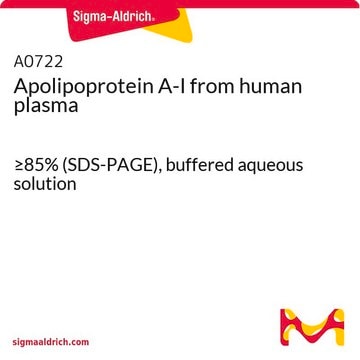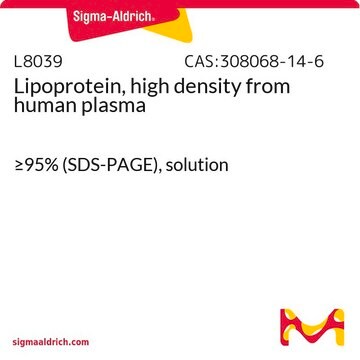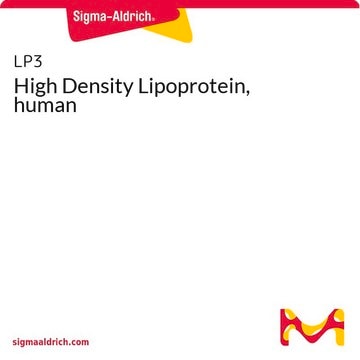MSST0002
SILu™Lite APOA1 Apolipoprotein A-1 human
recombinant, expressed in HEK 293 cells, MS Protein Standard
Synonym(e):
SILuLite Apolipoprotein A-1
About This Item
Empfohlene Produkte
Biologische Quelle
human
Qualitätsniveau
Rekombinant
expressed in HEK 293 cells
Markierung
His tagged
V5 tagged
Assay
≥98% (SDS-PAGE)
Form
lyophilized powder
Verpackung
vial of 50-65 μg (Lot-specific vial content given on certificate of analysis)
Methode(n)
mass spectrometry (MS): suitable
UniProt-Hinterlegungsnummer
Lagertemp.
−20°C
Angaben zum Gen
human ... APOA1(335)
Verwandte Kategorien
Biochem./physiol. Wirkung
Physikalische Form
Hinweis zur Analyse
SILuLite APOA1 is a recombinant human protein expressed in human 293 cells. It is a monomer of 286 amino acids (including N-terminal signal sequence and C-terminal polyhistidine and V5 tags), with a molecular weight of 32.1 kDa. SILuLite APOA1 is an analytical standard designed to be used as starting material for preparation of calibrators and controls in LC-MS applications.
Sequence
RHFWQQDEPPQSPWDRVKDLATVYVDVLKDSGRDYVSQFEGSALGKQLNLKLLDNWDSVTSTFSKLREQLGPVTQEFWDNLEKETEGLRQEMSKDLEEVKAKVQPYLDDFQKKWQEEMELYRQKVEPLRAELQEGARQKLHELQEKLSPLGEEMRDRARAHVDALRTHLAPYSDELRQRLAARLEALKENGGARLAEYHAKATEHLSTLSEKAKPALEDLRQGLLPVLESFKVSFLSALEEYTKKLNTQSDPSRGPFEGKPIPNPLLGLDSTRTGHHHHHHHHGGQ
The N-terminal signal peptide and C-terminal linker peptide, V5 and polyhistidine tags are italicized.
Other Characterization
- Sequence confirmed by intact mass analysis
- Identity verified by peptide mapping
- purity >98% (SDS-PAGE)
- Vial content was determined by the Bradford method using BSA as a calibrator. The correction factor of Bradford-to-AAA is 88.33%
Suggested Quantitative Analysis Parameters
(MRM settings provided for three suggested peptides)
Rechtliche Hinweise
Lagerklassenschlüssel
11 - Combustible Solids
WGK
WGK 3
Flammpunkt (°F)
Not applicable
Flammpunkt (°C)
Not applicable
Analysenzertifikate (COA)
Suchen Sie nach Analysenzertifikate (COA), indem Sie die Lot-/Chargennummer des Produkts eingeben. Lot- und Chargennummern sind auf dem Produktetikett hinter den Wörtern ‘Lot’ oder ‘Batch’ (Lot oder Charge) zu finden.
Besitzen Sie dieses Produkt bereits?
In der Dokumentenbibliothek finden Sie die Dokumentation zu den Produkten, die Sie kürzlich erworben haben.
Unser Team von Wissenschaftlern verfügt über Erfahrung in allen Forschungsbereichen einschließlich Life Science, Materialwissenschaften, chemischer Synthese, Chromatographie, Analytik und vielen mehr..
Setzen Sie sich mit dem technischen Dienst in Verbindung.






